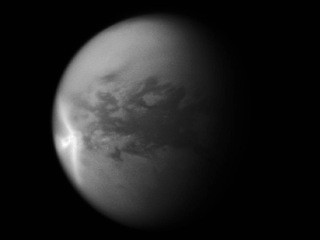Mystery Behind Arrow-shaped Cloud on Saturn Moon Explained

Researchers at University of California, Los Angeles (UCLA) have explained why Saturn's largest moon, Titan, has what looks like an enormous white arrow about the size of Texas on its surface.
The researchers used a global circulation model of Titan to demonstrate how planetary-scale atmospheric waves affect the moon’s weather patterns, leading to a “stencilling” effect that results in sharp and sometimes surprising cloud shapes.
The study was published in the Aug. 14 online edition of the journal Nature Geoscience.
"These atmospheric waves are somewhat like the natural, resonant vibration of a wine glass. Individual clouds might 'ring the bell', so to speak, and once the ringing starts, the clouds have to respond to that vibration,” said Jonathan L. Mitchell, an assistant professor of earth and space sciences and atmospheric and ocean sciences at UCLA who also led the research group.
Scientists have learned more about Saturn and its moon in recent years after the launch of NASA's Cassini Spacecraft, which has been in orbit around the distinctive planet since late 2004. The spacecraft has revolutionized scientists' understanding of Titan, which is the second-biggest moon in the solar system aside from Jupiter's Ganymede and is larger in volume than the planet Mercury.
The clouds resulting from Titan's atmospheric waves can cause precipitation up to 20 times the average seasonal rainfall, which researchers believe could be the key to the shaping of its surface by erosion. That would explain the presence of what appears to be numerous river patterns on the surface of the moon.
Researchers described Titan's climate as "all-tropics", with the entire planet experiencing the sort of weather that's only found near the equator on Earth.
"Our new results demonstrate the power of this analogy, not only for general features of Titan's climate but also for individual storms. In future work, we plan to extend our analysis to other Titan observations and make predictions of what clouds might be observed during the upcoming season,” Mitchell said.
"Titan is like Earth's strange sibling — the only other rocky body in the solar system that currently experiences rain," Mitchell said.
While Titan is an alien moon, researchers said it shares many similarities with Earth. The main component of its atmosphere is also molecular nitrogen and water is abundant, although it is frozen in the crust at extremely low temperatures. In addition, like Earth, methane is thermodynamically active in the lower atmospheres, which form rain clouds that are resupplied from surface sources, much like water vapor on our planet.
Researchers hypothesize that Earth may have had an atmosphere like Titan's - with large amounts of methane and limited oxygen - shortly after its atmosphere formed. It is possible that methane provided a necessary greenhouse warming that prevented Earth from staying in a frozen state.
"Therefore, by studying Titan's modern climate, we may gain new insights about the way the early Earth's climate was," Mitchell said.
© Copyright IBTimes 2024. All rights reserved.





















